CrossFit movements are essential for building strength‚ endurance‚ and agility․ They include foundational exercises like squats and presses‚ functional movements‚ Olympic lifts‚ and gymnastics; These movements are designed to improve overall fitness and prepare individuals for various physical challenges‚ making them a cornerstone of CrossFit training․
1․1 What Are CrossFit Movements?
CrossFit movements are a series of exercises designed to enhance functional fitness and overall athleticism․ These movements are scalable‚ meaning they can be adjusted to suit different fitness levels․ They include exercises like squats‚ deadlifts‚ and presses‚ as well as Olympic lifts and gymnastics movements․ CrossFit movements are performed in workouts of the day (WODs) and are intended to improve strength‚ endurance‚ agility‚ and coordination․ They are structured to mimic real-life activities‚ making them practical for everyday functionality and athletic performance․
1․2 Importance of Mastering CrossFit Movements
Mastering CrossFit movements is crucial for improving overall fitness‚ preventing injuries‚ and enhancing athletic performance․ Proper form ensures efficiency and safety‚ while consistency builds strength and endurance․ Scalable movements allow individuals to progress at their own pace‚ making CrossFit accessible to all fitness levels․ Mastery fosters confidence and readiness for various physical challenges‚ both in and out of the gym․ By focusing on technique and progressive overload‚ athletes can maximize results and achieve long-term success in their CrossFit journey․
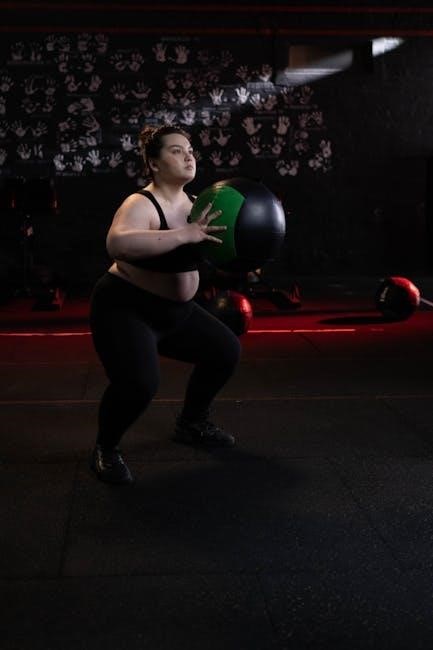
Foundational CrossFit Movements
Foundational CrossFit movements include squats‚ presses‚ and pulls‚ forming the basis of functional fitness․ These exercises build strength‚ agility‚ and coordination‚ essential for advanced techniques․
2․1 The 9 Foundational Movements
The 9 foundational CrossFit movements are the air squat‚ front squat‚ overhead squat‚ press‚ push press‚ push jerk‚ deadlift‚ sumo deadlift high pull‚ and Clean․ These exercises form the core of CrossFit training‚ focusing on proper form and technique․ They are designed to improve flexibility‚ strength‚ and coordination‚ providing a solid foundation for more complex movements․ Each movement targets different muscle groups and is essential for building overall fitness and athleticism․
2․2 Detailed Explanation of Each Foundational Movement
The air squat is a bodyweight movement that enhances flexibility and strength․ The front squat targets the quads and core‚ while the overhead squat improves mobility and shoulder stability․ The press focuses on shoulder strength‚ and the push press incorporates leg drive for more power․ The push jerk involves explosive power and precise positioning․ The deadlift and sumo deadlift high pull work on posterior strength and pulling power․ The Clean is a dynamic movement that combines speed and strength‚ emphasizing proper form throughout․ Each movement is fundamental for building a strong CrossFit base․
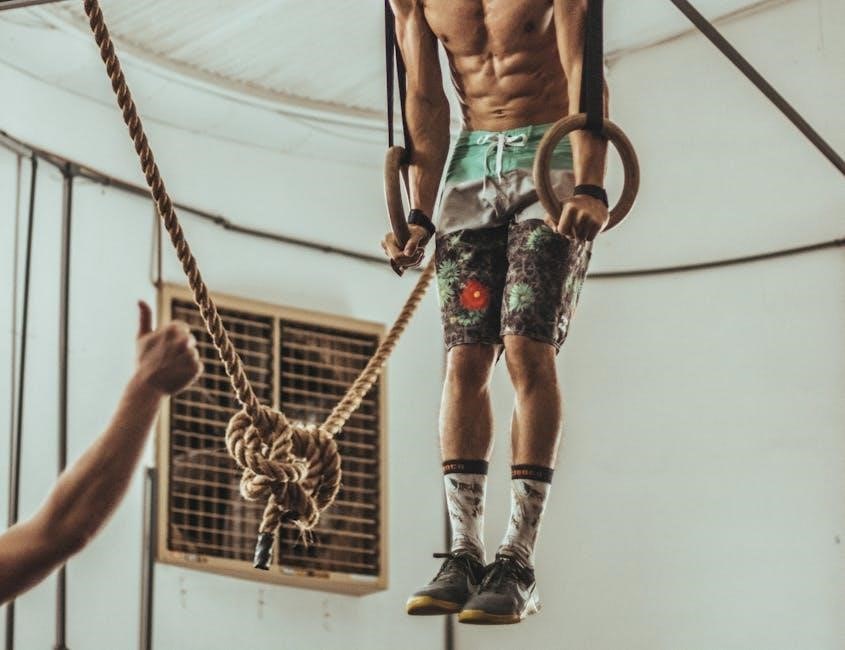
Advanced CrossFit Movements
Advanced movements like muscle-ups‚ handstand walks‚ and heavy Olympic lifts challenge experienced athletes‚ requiring precision and strength to enhance performance and overall fitness effectively․
3․1 Progressing from Foundational to Advanced Movements
Progressing from foundational to advanced CrossFit movements requires consistent practice‚ patience‚ and a focus on proper form․ Athletes should master basic techniques‚ such as squats and push-ups‚ before introducing more complex movements like muscle-ups or handstand walks․ Gradually increasing intensity and incorporating strength training helps build the necessary skills and confidence․ Scaling movements appropriately ensures safety and steady improvement․ Coaches often emphasize the importance of understanding each movement’s mechanics and progressively challenging oneself without compromising form․ This structured approach prevents injuries and fosters long-term development in CrossFit․
3․2 Key Advanced Movements in CrossFit
Advanced CrossFit movements include complex exercises like muscle-ups‚ handstand walks‚ and the snatch․ These require full-body engagement‚ coordination‚ and precision․ Movements such as the clean and jerk‚ overhead squats‚ and ring dips are also considered advanced‚ as they demand high levels of strength and technical proficiency․ These exercises are integral to CrossFit programming‚ pushing athletes to new levels of fitness and skill․ Mastery of these movements enhances overall athleticism and prepares individuals for competitive CrossFit environments․
Olympic Lifts in CrossFit
Olympic lifts‚ such as the snatch and clean and jerk‚ are dynamic‚ full-body movements emphasizing power and precision․ They are central to CrossFit training․
4․1 Overview of Olympic Lifts
Olympic lifts are dynamic‚ full-body movements that require precision and power․ They include the snatch and clean and jerk‚ emphasizing speed‚ strength‚ and coordination․ These lifts are central to CrossFit‚ replicating functional patterns and enhancing overall athleticism․ They engage multiple muscle groups‚ improving explosiveness and neuromuscular efficiency․ Proper technique is crucial for safety and effectiveness․ Olympic lifts are a cornerstone of CrossFit programming‚ offering a challenging yet rewarding way to build strength and speed․
4․2 Techniques and Safety Tips for Olympic Lifts
Mastering Olympic lifts requires precise technique to minimize injury risk․ Maintain a neutral spine‚ engage your core‚ and generate power from your hips․ Avoid rounding your back or losing grip mid-lift․ Use hooks for heavier loads and ensure proper foot placement․ Start with lighter weights to build strength and coordination․ Regular coaching feedback is essential to correct form․ Warm up thoroughly and focus on explosive drive during the lifts․ Prioritize controlled movements over speed to ensure safety and effectiveness․
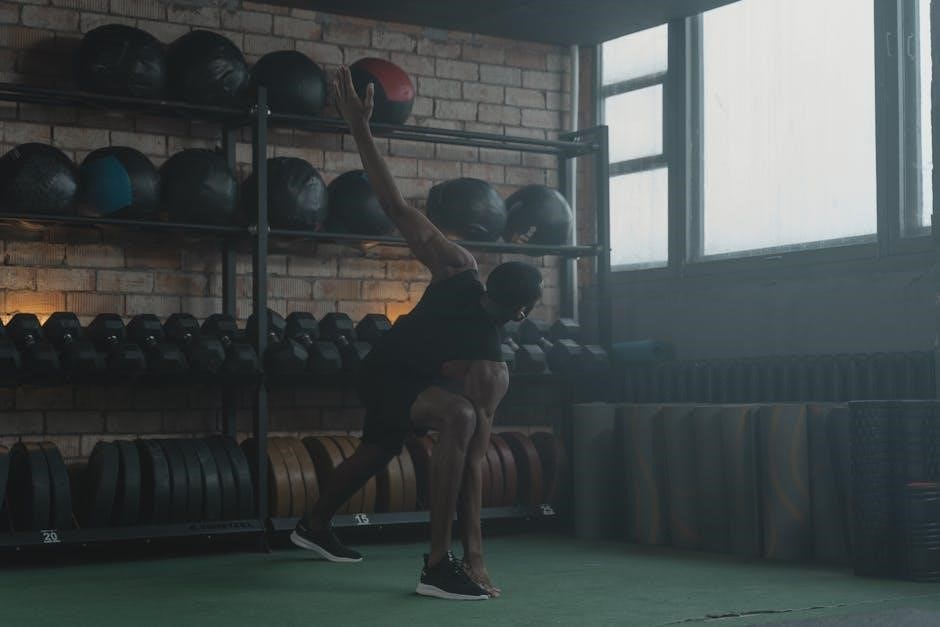
Functional Movements in CrossFit
Functional movements mimic real-life actions‚ enhancing mobility and practical strength․ They include squats‚ lunges‚ and step-ups‚ focusing on natural patterns to improve daily functionality and athletic performance․
5․1 Definition and Purpose of Functional Movements
Functional movements are exercises that mimic real-life activities‚ focusing on natural patterns like squatting‚ lunging‚ and pressing․ These movements improve mobility and strength for daily tasks and athletics․
Their purpose is to enhance practical fitness by targeting multiple muscle groups‚ promoting coordination‚ and preparing the body for varied physical demands․ Functional movements are scalable‚ making them accessible to all fitness levels and essential for CrossFit training․
5․2 Examples of Functional Movements in CrossFit
Functional movements in CrossFit include squats‚ lunges‚ deadlifts‚ bench presses‚ pull-ups‚ and rows․ These exercises mimic real-life actions‚ enhancing practical fitness․
- Squats: Strengthen legs and core․
- Deadlifts: Improve full-body strength and posture․
- Push-ups: Build upper body and core stability․
- Pull-ups: Develop upper body strength and endurance․
These movements are scalable and integral to CrossFit workouts‚ promoting versatility and real-world application․
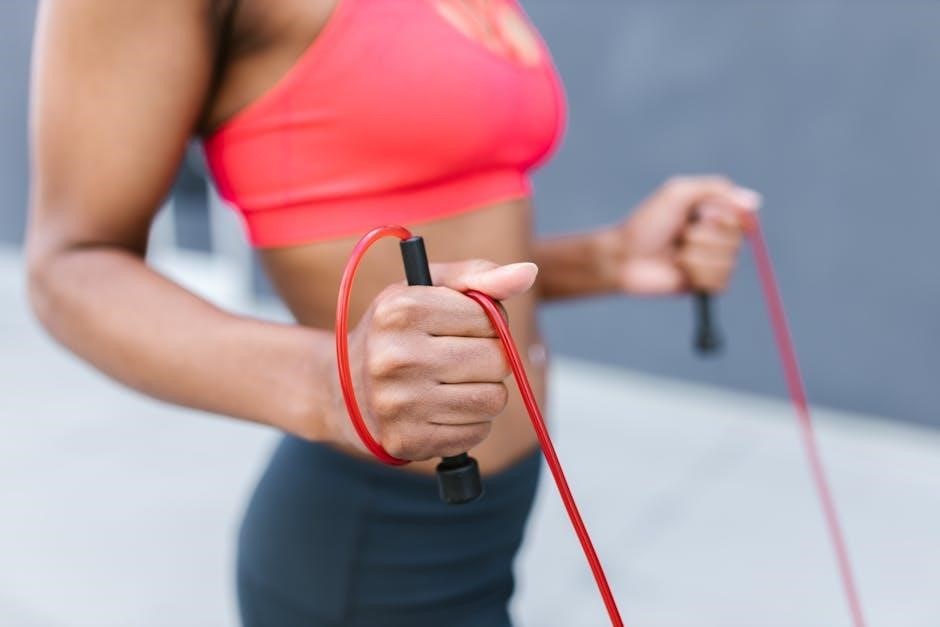
Gymnastics Movements in CrossFit
CrossFit gymnastics movements include bodyweight exercises like pull-ups‚ dips‚ muscle-ups‚ and handstand push-ups․ These movements build strength‚ coordination‚ and flexibility‚ focusing on functional‚ dynamic abilities․
- Muscle-ups: Combine pull-ups and dips for full-body engagement․
- Handstand push-ups: Strengthen shoulders and core while improving balance․
These exercises are integral for developing overall athleticism and movement proficiency in CrossFit training․
Gymnastics movements in CrossFit are bodyweight exercises that build strength‚ coordination‚ and flexibility․ They include exercises like pull-ups‚ dips‚ muscle-ups‚ and handstand push-ups‚ which require precise technique and body control․ These movements are designed to enhance overall athleticism and improve functional movement patterns․ Unlike weighted exercises‚ gymnastics-focused movements rely on the individual’s body weight as resistance‚ making them accessible and effective for building strength and endurance․ Mastery of these movements is key to advancing in CrossFit and improving performance in workouts of the day (WODs)․
6․2 Common Gymnastics Movements Used in CrossFit
Common gymnastics movements in CrossFit include pull-ups‚ dips‚ muscle-ups‚ handstand push-ups‚ and rope climbs․ These exercises enhance strength‚ coordination‚ and flexibility․ Pull-ups work the upper body‚ while dips target the chest and triceps․ Muscle-ups combine pull-ups and dips for a full-body movement; Handstand push-ups build shoulder strength and core stability․ Rope climbs improve grip and full-body coordination․ These movements are integral to CrossFit‚ promoting functional fitness and versatility․ They are often scaled to suit different fitness levels‚ ensuring accessibility for all athletes․
Understanding Movement Categories
CrossFit movements are categorized into foundational‚ functional‚ and advanced․ These categories help structure workouts based on fitness levels‚ ensuring progression and proper technique․
7․1 Differences Between Foundational‚ Functional‚ and Advanced Movements
Foundational movements‚ such as squats and push-ups‚ form the basis of CrossFit‚ focusing on basic techniques․ Functional movements‚ like thrusters and cleans‚ simulate real-life actions․ Advanced movements‚ including muscle-ups and snatches‚ require higher skill levels and strength․ Each category builds on the previous‚ ensuring a progressive approach to fitness․ Understanding these distinctions helps athletes choose appropriate exercises for their skill level‚ promoting effective training and injury prevention․
7․2 How to Choose the Right Movements for Your Fitness Level
Choosing the right CrossFit movements involves assessing your current fitness level and goals․ Start with foundational movements to build a strong base‚ then gradually incorporate functional exercises as you progress․ Advanced movements should only be attempted when proper form and strength are achieved․ Always consider scaling options to ensure safety and effectiveness․ Tailoring your workout to your fitness level ensures continuous improvement and reduces injury risk‚ helping you achieve a well-rounded and balanced fitness development․
Learning and Mastering CrossFit Movements
Mastery of CrossFit movements requires consistent practice‚ attention to form‚ and progressive overload․ Start with foundational exercises‚ then gradually incorporate more complex movements as skill and strength improve․
8․1 Step-by-Step Guide to Learning New Movements
Learning CrossFit movements begins with understanding proper form and mechanics․ Start by breaking down each movement into its components‚ focusing on technique over intensity․ Practice with lighter weights or bodyweight to build muscle memory․ Gradually increase load and complexity as confidence and proficiency grow․ Seek feedback from coaches or experienced athletes to correct deficiencies․ Consistency and patience are key; mastering movements takes time and dedication․ Regular practice ensures progress and reduces injury risk․
8․2 Common Mistakes to Avoid When Performing CrossFit Movements
One common mistake is neglecting proper form to lift heavier weights‚ which can lead to injuries․ Overlooking warm-ups and cool-downs is another error‚ as they are crucial for preventing muscle strain․ Many athletes rush through movements‚ sacrificing technique for speed‚ which can hinder progress and increase injury risk․ Additionally‚ ignoring breathing patterns and core engagement often results in poor performance and instability․ Focusing on quality over quantity ensures safer and more effective workouts․
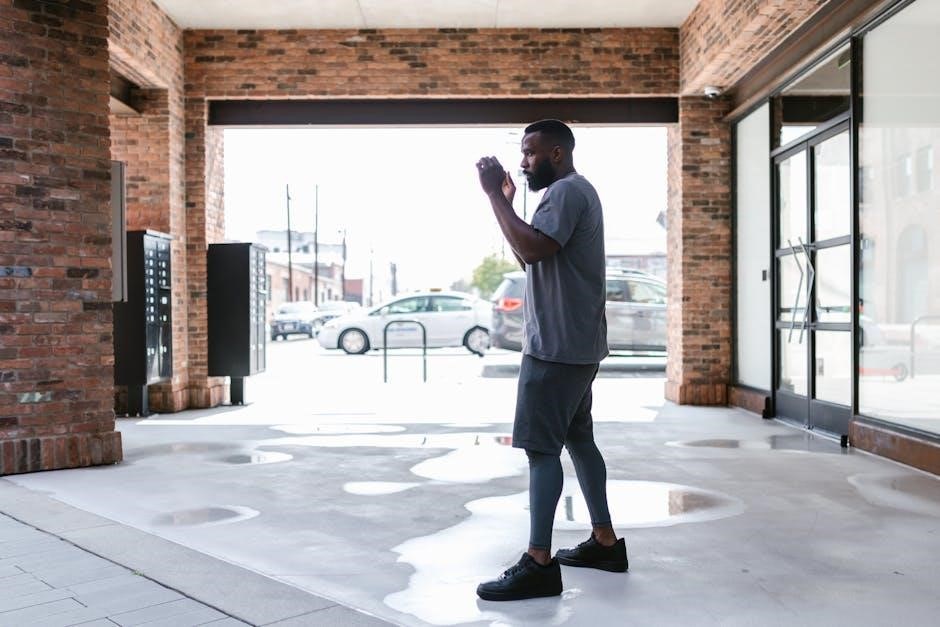
Safety and Injury Prevention
Safety and injury prevention are crucial in CrossFit․ Proper form‚ warm-ups‚ and equipment use reduce injury risks․ Prioritizing technique ensures effective workouts and long-term health benefits․
9․1 Warm-Up Routines for CrossFit Movements
A proper warm-up is essential for CrossFit movements․ It includes dynamic stretching‚ light cardio‚ and muscle activation to prepare the body for intense workouts․ Spend 10-15 minutes on activities like jumping jacks‚ arm circles‚ and leg swings․ Incorporate mobilization exercises for joints and muscle groups used in the workout․ A well-structured warm-up enhances performance‚ reduces injury risk‚ and ensures readiness for the movements ahead․ Consistency in warming up is key to maintaining safety and effectiveness in CrossFit training․
9․2 Injury Prevention Tips for CrossFit Athletes
Injury prevention in CrossFit requires attention to proper form‚ consistent practice‚ and scaled movements․ Prioritize technique over intensity to minimize risk․ Incorporate static stretching post-workout to lengthen muscles and improve flexibility․ Maintain a positive mindset to avoid fear and worry‚ which can hinder performance․ Focus on progressive overload and avoid rushing through exercises․ Ensure adequate rest and recovery to prevent overtraining․ By combining these strategies‚ athletes can reduce injury risks and maintain long-term fitness gains․

Programming and Scaling CrossFit Movements
Effective programming integrates movements into workouts‚ ensuring variety and progression․ Scaling adjustments allow athletes of all levels to perform safely and efficiently‚ promoting consistent growth and engagement․
10․1 How to Incorporate Movements into Workouts
Integrating CrossFit movements into workouts involves selecting exercises that align with fitness goals․ Coaches often structure WODs (Workouts of the Day) by combining strength‚ skill‚ and conditioning․ For example‚ pairing squats with pull-ups or blending Olympic lifts with gymnastics creates balanced routines․ Progression is key; starting with foundational movements ensures proper form before advancing․ Each exercise is chosen to enhance functional fitness‚ making workouts efficient and purposeful for all athletes‚ regardless of their skill level or objectives․
10․2 Scaling Options for Different Fitness Levels
CrossFit movements can be scaled to suit various fitness levels‚ ensuring accessibility and safety․ For beginners‚ reducing intensity or modifying exercises (e․g․‚ knee push-ups instead of pull-ups) is common․ Advanced athletes can increase weight‚ reps‚ or complexity․ Scaling options include using resistance bands‚ lowering weights‚ or substituting movements (e․g․‚ box jumps instead of burpees)․ Coaches often tailor WODs to individual capabilities‚ ensuring progress and preventing injury․ This approach keeps workouts challenging yet achievable for all athletes‚ fostering growth and engagement․
CrossFit Movements in Workouts of the Day (WODs)
CrossFit movements are integral to WODs‚ combining strength‚ conditioning‚ and skill․ Each WOD incorporates a variety of exercises to enhance overall fitness and performance capabilities․
11․1 Role of Movements in WOD Design
CrossFit movements play a central role in WOD design‚ as they are carefully selected to enhance conditioning‚ strength‚ and skill․ Each movement is chosen for its ability to improve functional fitness and promote overall athleticism․ WODs are designed to be scalable‚ ensuring that athletes of all levels can participate effectively․ The combination of movements in a WOD aims to create a balanced workout that challenges multiple fitness domains simultaneously‚ preventing plateaus and fostering continuous progress․ This structured approach ensures that each WOD is engaging‚ varied‚ and purpose-driven․
11․2 Examples of WODs That Highlight Key Movements
Examples of WODs showcasing key CrossFit movements include “Cindy‚” which focuses on pull-ups‚ push-ups‚ and air squats‚ and “Annie‚” emphasizing double-unders and push-ups․ Another example is “Fran‚” a high-intensity WOD combining thrusters and pull-ups․ These workouts are designed to test endurance‚ strength‚ and technique‚ while highlighting specific movements․ Each WOD is structured to challenge athletes in unique ways‚ ensuring a well-rounded fitness experience․ By incorporating a variety of movements‚ WODs like these help improve overall athleticism and functional fitness․
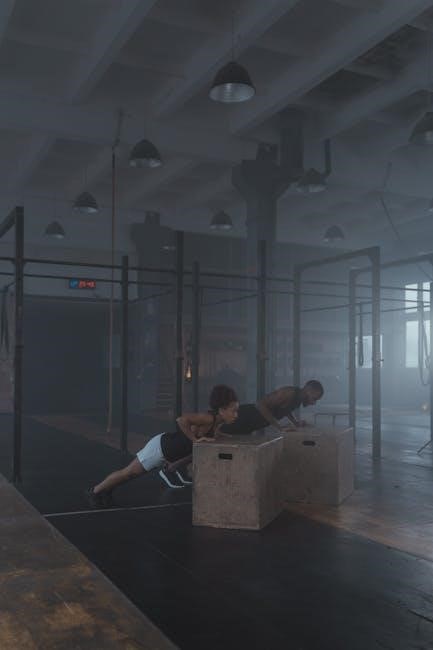
Combining Movements for Effective Workouts
Combining movements enhances efficiency and engages the entire body․ Pairing thrusters with pull-ups or squats with presses creates balanced workouts‚ improving strength and endurance while preventing plateaus․
12․1 Tips for Pairing Movements for Maximum Efficiency
Pair movements that complement each other‚ such as squats with shoulder presses or deadlifts with pull-ups‚ to optimize time and energy․ Start with compound movements to engage multiple muscle groups‚ then isolate specific areas for targeted development․ Alternate between strength-focused exercises and conditioning drills‚ like pairing Olympic lifts with sprints‚ to balance intensity and endurance․ Incorporate static stretches post-workout to improve flexibility and recovery․ Consistency in pairing movements helps build muscle memory and mastery‚ ensuring progressive overload and continuous improvement․
12․2 Creating Balanced and Varied Workout Routines
A balanced workout routine incorporates a mix of strength‚ conditioning‚ and mobility․ Alternate between push and pull movements to avoid muscle imbalance․ Pair aerobic exercises like sprints with anaerobic ones like squats for well-rounded fitness․ Incorporate scalability options to cater to different fitness levels․ Use progressive overload to gradually increase intensity․ Include functional movements that mimic real-life tasks to enhance practical fitness․ Ensure variety by rotating exercises weekly to prevent plateaus and keep workouts engaging․ Mobility work‚ such as stretching and foam rolling‚ should be integrated to improve recovery and flexibility․
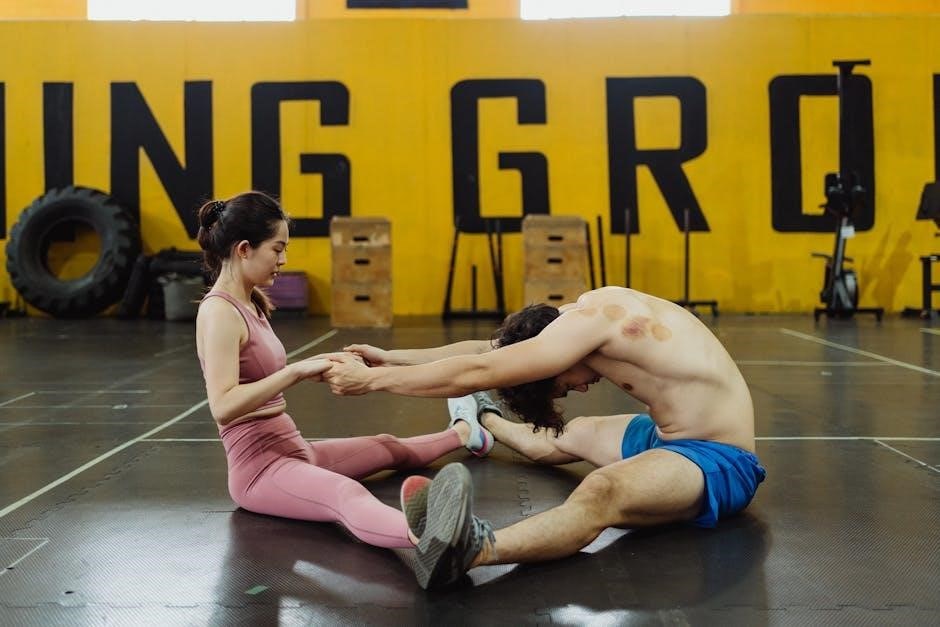
Progression and Mastery of CrossFit Movements
Progression involves increasing intensity or complexity‚ while mastery requires consistent practice and perfecting form․ Both ensure safe and effective improvement in CrossFit movements over time․
13․1 How to Progress from Basic to Advanced Movements
Progressing from basic to advanced CrossFit movements requires patience‚ consistent practice‚ and a focus on proper form․ Start with foundational movements like squats and presses‚ gradually increasing intensity by adding weight or complexity․ Once mastery of basics is achieved‚ introduce Olympic lifts and gymnastics movements․ Scale exercises to suit fitness levels‚ ensuring safety and efficiency․ Over time‚ combine movements into fluid sequences to enhance performance and build overall athleticism․
13․2 Achieving Mastery in CrossFit Movements
Achieving mastery in CrossFit movements requires dedication‚ consistent practice‚ and a deep understanding of proper form․ Focus on breaking down each movement into its components‚ ensuring precision and control․ Incrementally increase intensity and complexity as skill improves․ Utilize tools like video analysis and coaching feedback to refine technique․ Regularly incorporate mobility and recovery practices to maintain performance and prevent injury․ Mental focus and patience are equally important‚ as mastery is a long-term journey rather than a quick achievement․
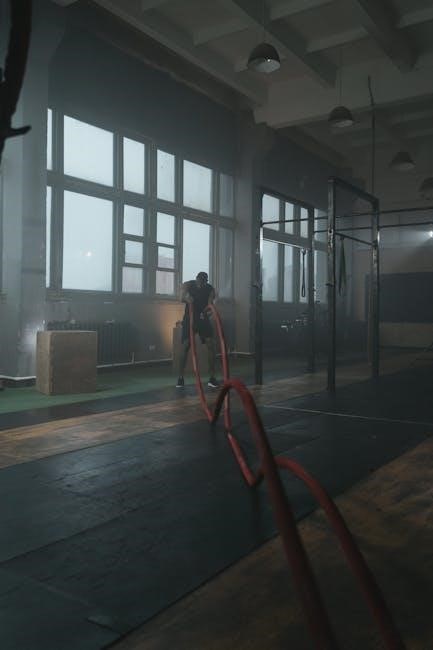
The Role of Consistency and Practice
Consistency and practice are crucial for improving CrossFit movements․ Regular training builds strength‚ skill‚ and endurance‚ ensuring progressive development and overall fitness․
14․1 Importance of Regular Practice in Movement Mastery
Regular practice is essential for mastering CrossFit movements․ Consistency helps develop muscle memory‚ improves technique‚ and enhances overall performance․ Through dedicated practice‚ athletes build strength‚ coordination‚ and endurance‚ enabling them to progress safely and effectively․ Regular training also fosters mental discipline and confidence‚ which are critical for advancing in CrossFit․ By committing to consistent practice‚ individuals ensure continuous improvement and achieve their fitness goals more efficiently․
14․2 How to Stay Consistent with CrossFit Training
Consistency in CrossFit requires a structured approach․ Set realistic goals and create a schedule to ensure regular attendance․ Tracking progress through journals or apps helps maintain motivation․ Building a support system‚ such as training with a partner or joining a community‚ enhances commitment․ Celebrating small achievements and staying positive keeps the journey enjoyable․ Additionally‚ incorporating variety in workouts prevents boredom‚ ensuring long-term adherence to the program․ Staying consistent leads to sustainable progress and mastery of movements‚ making it a key factor in achieving CrossFit success․
CrossFit movements are fundamental for building strength‚ technique‚ and overall fitness․ Consistency and proper form are key to mastering these exercises‚ ensuring long-term progress and success․
15․1 Summary of Key Points
CrossFit movements encompass a wide range of exercises designed to enhance strength‚ endurance‚ and agility․ Foundational movements‚ such as squats and presses‚ form the basis of CrossFit training․ Olympic lifts‚ like the clean and jerk‚ and gymnastics movements‚ such as pull-ups and handstands‚ add complexity and variety․ Functional movements mimic real-life actions‚ improving practical fitness․ Consistency and proper form are crucial for mastering these exercises․ Scaling options ensure accessibility for all fitness levels‚ making CrossFit a versatile and effective training system for achieving overall physical preparedness and well-being․
15․2 Final Thoughts on CrossFit Movements and Their Importance
CrossFit movements are a cornerstone of effective and varied training‚ offering a holistic approach to fitness․ By combining foundational exercises‚ Olympic lifts‚ and gymnastics‚ CrossFit enhances strength‚ endurance‚ and agility․ The structured progression and scalability of these movements make them accessible to all fitness levels‚ fostering a strong sense of community․ Consistency and proper form are key to mastering these exercises․ Embracing CrossFit movements leads to overall physical preparedness and a healthier lifestyle‚ making them indispensable for anyone seeking a transformative fitness journey․
